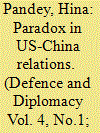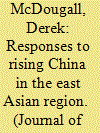| Srl | Item |
| 1 |
ID:
091638


|
|
|
|
|
| Publication |
2009.
|
| Summary/Abstract |
Japan and China's ability to manage their bilateral relationship is crucial for the stability of the East Asian region. It also has a global impact on the security and economic development of other regions. For just as China's rise has inevitably involved an expansion of its global reach, so Japan's responses to the challenges posed by China have increasingly taken a global form, seeking to incorporate new partners and frameworks outside East Asia. Japan's preferred response to China's regional and global rise in the post-Cold War period has remained one of default engagement. Japan is intent on promoting China's external engagement with the East Asia region and its internal domestic reform, through upgrading extant bilateral and Japan-China-US trilateral frameworks for dialogue and cooperation, and by emphasizing the importance of economic power to influence China. Japan is deliberately seeking to proliferate regional frameworks for cooperation in East Asia in order to dilute, constrain and ultimately engage China's rising power. However, Japan's engagement strategy also contains the potential to tilt towards default containment. Japan's domestic political basis for engagement is becoming increasingly precarious as China's rise stimulates Japanese revisionism and nationalism. Japan also appears increasingly to be looking to contain China on a global scale by forging new strategic links in Russia and Central Asia, with a 'concert of democracies' involving India, Australia and the US, by competing for resources with China in Africa and the Middle East, and by attempting to articulate a values-based diplomacy to check the so-called 'Beijing consensus'. Nevertheless, Japan's perceived inability to channel China's rise either through regional engagement or through global containment carries a further risk of pushing Japan to resort to the strengthening of its military power in an attempt to guarantee its essential national interests. It is in this instance that Japan and China run the danger of a military collision.
|
|
|
|
|
|
|
|
|
|
|
|
|
|
|
|
| 2 |
ID:
137574


|
|
|
| 3 |
ID:
110068


|
|
|
|
|
| Publication |
2012.
|
| Summary/Abstract |
While the strategic response to 'rising China' in the broader East Asian region has been varied, the strongest emphasis has been on 'soft balancing'. This approach is clearly evident in the strategies pursued by the most significant of the major powers, the United States, Japan and India, as well as by other powers such as Australia, Indonesia and Vietnam. However, other responses such as accommodation and hedging have also featured for various states within the region. Frequently the response of a particular state will involve a number of elements. Soft balancing is most prominent in relation to the security dimension. Economic interaction encourages other kinds of responses. Whatever the overall approach adopted, a key factor is domestic politics, particularly the perceptions of the relevant elites.
|
|
|
|
|
|
|
|
|
|
|
|
|
|
|
|
| 4 |
ID:
162537


|
|
|
|
|
| Summary/Abstract |
The study of financial market efficiency has important implications in terms of global macroeconomic stability. The case of six selected East Asian stock markets (China, Japan, Hong Kong, Malaysia, Singapore and South Korea) during the Asian Financial Crisis (AFC) and Global Financial Crisis (GFC) is analysed here using a battery of well-known econometric techniques that starts with traditional unit root testing for random walk behaviour. The six countries were selected on the basis of market capitalization to offer insights into the behaviour of the most relevant markets in the region. The results show that during both crises, these markets exhibited significant inefficiencies. This is shown by the fact that positive correlations characterized markets returns behaviour in general, except for South Korea and Hong Kong, during the GFC. Of particular note is the case of China; its stock markets suffered losses and high volatility during the GFC and exhibited increasing correlations with other stock markets in the region, showing progressive levels of integration within the region and more exposure to global events.
|
|
|
|
|
|
|
|
|
|
|
|
|
|
|
|